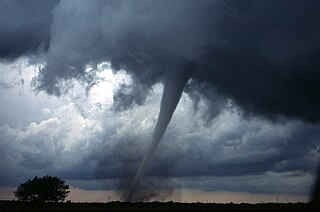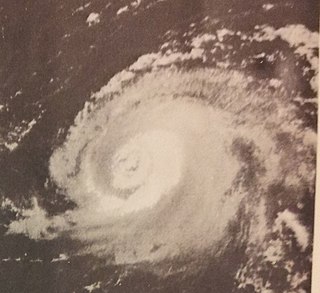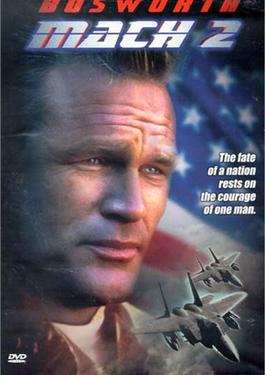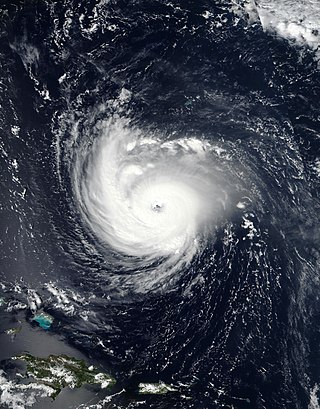
Cat's Cradle is a satirical postmodern novel, with science fiction elements, by American writer Kurt Vonnegut. Vonnegut's fourth novel, it was first published on March 18, 1963, exploring and satirizing issues of science, technology, the purpose of religion, and the arms race, often through the use of morbid humor.

Weather modification is the act of intentionally manipulating or altering the weather. The most common form of weather modification is cloud seeding, which increases rainfall or snowfall, usually for the purpose of increasing the local water supply. Weather modification can also have the goal of preventing damaging weather, such as hail or hurricanes, from occurring; or of provoking damaging weather against an enemy, as a tactic of military or economic warfare like Operation Popeye, where clouds were seeded to prolong the monsoon in Vietnam. Weather modification in warfare has been banned by the United Nations under the Environmental Modification Convention.

Hurricane Connie was a Category 4 hurricane that contributed to significant flooding across the eastern United States in August 1955, just days before Hurricane Diane affected the same general area. Connie formed on August 3 from a tropical wave in the eastern Atlantic Ocean. It moved quickly west-northwestward, strengthening into a hurricane by August 4. Connie first posed a threat to the Lesser Antilles, ultimately passing about 105 mi (169 km) north of the island group. In the United States Virgin Islands, three people died due to the hurricane, and a few homes were destroyed. The outer rainbands produced hurricane-force wind gusts and intense precipitation, reaching 8.65 in (220 mm) in Puerto Rico. On the island, Connie destroyed 60 homes and caused crop damage. After affecting Puerto Rico, Connie reached maximum sustained winds of 140 mph (230 km/h), and a barometric pressure of 944 mbar (27.9 inHg), as observed by the Hurricane Hunters on August 7. The hurricane later weakened, slowed its forward motion, and turned to the north, striking North Carolina on August 12 as a Category 2 on the Saffir-Simpson scale. Connie was the first of three damaging tropical cyclones in the 1955 hurricane season to hit the state, along with Diane and Ione. The storm progressed inland after moving through the Chesapeake Bay region, and was later absorbed by a cold front over Lake Huron on August 15.

Project Stormfury was an attempt to weaken tropical cyclones by flying aircraft into them and seeding them with silver iodide. The project was run by the United States Government from 1962 to 1983. The hypothesis was that the silver iodide would cause supercooled water in the storm to freeze, disrupting the inner structure of the hurricane, and this led to seeding several Atlantic hurricanes. However, it was later shown that this hypothesis was incorrect. It was determined that most hurricanes do not contain enough supercooled water for cloud seeding to be effective. Additionally, researchers found that unseeded hurricanes often undergo the same structural changes that were expected from seeded hurricanes. This finding called Stormfury's successes into question, as the changes reported now had a natural explanation.

The Secret Storm is an American television soap opera that aired on CBS from February 1, 1954, to February 8, 1974. It was created by Roy Winsor, who also created the long-running soap operas Search for Tomorrow and Love of Life. Gloria Monty, of General Hospital fame, was a longtime director of the series.

Hurricane Donna, known in Puerto Rico as Hurricane San Lorenzo, was the strongest hurricane of the 1960 Atlantic hurricane season, and caused severe damage to the Lesser Antilles, the Greater Antilles, and the East Coast of the United States, especially Florida, in August–September. The fifth tropical cyclone, third hurricane, and first major hurricane of the season, Donna developed south of Cape Verde on August 29, spawned by a tropical wave to which 63 deaths from a plane crash in Senegal were attributed. The depression strengthened into Tropical Storm Donna by the following day. Donna moved west-northwestward at roughly 20 mph (32 km/h) and by September 1, it reached hurricane status. Over the next three days, Donna deepened significantly and reached maximum sustained winds of 130 mph (210 km/h) on September 4. Thereafter, it maintained intensity as it struck the Lesser Antilles later that day. On Sint Maarten, the storm left a quarter of the island's population homeless and killed seven people. An additional five deaths were reported in Anguilla, and there were seven other fatalities throughout the Virgin Islands. In Puerto Rico, severe flash flooding led to 107 fatalities, 85 of them in Humacao alone.

World War III is a miniseries that aired on the NBC television network on January 31, 1982.

Now and Again is an American science fiction comedy-drama television series created by Glenn Gordon Caron that aired on CBS from September 24, 1999 until May 5, 2000. The story revolves around the United States government engineering the perfect human body for use in espionage, but not being able to perfect the brain. In an attempt to get the project up and running, they take the brain of overweight family man Michael Wiseman, who is killed in a train accident.

Typhoon Cobra, also known as the Typhoon of 1944 or Halsey's Typhoon, was the United States Navy designation for a powerful tropical cyclone that struck the United States Pacific Fleet in December 1944, during World War II. The storm sank three destroyers, killed 790 sailors, damaged 9 other warships, and swept dozens of aircraft overboard off their aircraft carriers.

The Invisible Man is a British black-and-white science fiction television series that aired on ITV. It aired from September 1958 to July 1959, on CBS in the USA, two seasons. Of which these shows amounted to twenty-six one-half-hour episodes. This series was loosely inspired by the 1897 novel which was authored by the famous H. G. Wells. This television program was one of at least four 'Invisible Men' television series. This interation deviates from the novel making the character's name Dr. Peter Brady. The character remains sane, opposed to a lunatic as in the book or the 1933 film adaptation. No characters from the novel appear in the series.

Hurricane Esther was the first large tropical cyclone to be discovered by satellite imagery. The fifth tropical cyclone, named storm, and hurricane of the 1961 Atlantic hurricane season, Esther developed from an area of disturbed weather hundreds of miles west-southwest of the southernmost Cape Verde Islands on September 10. Moving northwestward, the depression strengthened into Tropical Storm Esther on September 11, before reaching hurricane intensity on the following day. Early on September 13, Esther curved westward and deepened into a major hurricane. The storm remained a Category 3 hurricane for about four days and gradually moved in a west-northwestward direction. Late on September 17, Esther strengthened into a Category 5 hurricane with sustained winds of 160 mph (260 km/h) on September 18. The storm curved north-northeastward on September 19, while offshore of North Carolina. Esther began to weaken while approaching New England and fell to Category 3 intensity on September 21. The storm turned eastward early on the following day, and rapidly weakened to a tropical storm.

Robert H. Simpson was an American meteorologist, hurricane specialist, first director of the National Hurricane Research Project (NHRP) from 1955 to 1959, and a former director (1967–1974) of the National Hurricane Center (NHC). He was the co-developer of the Saffir–Simpson Hurricane Scale with Herbert Saffir. His wife was Joanne Simpson.
Superstorm is a three-part British docudrama miniseries written and directed by Julian Simpson, about a group of scientists that try to divert and weaken hurricanes using cloud seeding.
The Storm is a 2009 American science fiction disaster miniseries directed by Bradford May. Based on a previous teleplay by Matthew Chernov and David Rosiak, it was written by David Abramowitz and Dennis A. Pratt and revolves around a weather creation system developed by the Atmospheric Research Institute that threatens life on Earth when deployed by the military. However, while scientist Dr. Jonathan Kirk, Danni Wilson, and detectives Devon Williams and Stilman attempt to save the world, the former is hunted by hitmen.

Hurricane Debbie was an intense and long-lived hurricane that formed during August 1969. The fifth tropical cyclone, fourth named storm, third hurricane and second major hurricane of the 1969 Atlantic hurricane season, Debbie formed on August 14 in the southern Atlantic Ocean and took a general northwesterly path until turning northward into the central Atlantic. The storm was characterized by numerous fluctuations in intensity, but it still reached winds corresponding to Category 3 status on the Saffir–Simpson scale. The hurricane bypassed the island of Bermuda to the southeast on August 22, before ultimately brushing southeastern Newfoundland with strong winds. It dissipated over the cold waters east of Greenland. Although Debbie had little effect on land, it was extensively researched and was subject to a weather modification experiment by Project Stormfury, in which it was seeded with silver iodide.

New Alcatraz, is a 2002 American direct-to-video science fiction action horror film. It was directed by Phillip Roth and starred Dean Cain. In the middle of Antarctica, a high maximum-security prison called New Alcatraz has recently become operational. When a mining crew inside the prison accidentally drills into a strange rock formation, a giant prehistoric snake is unleashed upon the prison and goes on a killing rampage. It is up to the prison staff, inmates, two paleontologists, and a group of soldiers to hunt down and eliminate the beast.

Mach 2 is a 2001 American direct-to-video action disaster thriller film directed by Fred Olen Ray. It was the first film to feature the airliner Concorde being hijacked.

Storm Over the Andes is a 1935 American adventure film directed by Christy Cabanne and starring Jack Holt, Antonio Moreno and Mona Barrie. The low-budget programmer is set against the backdrop of the Chaco War between Paraguay and Bolivia. A separate Spanish-language version, titled Alas Sobre El Chaco, also directed by Cabanne, was made.

Hurricane Florence was a powerful and long-lived tropical cyclone that caused catastrophic damage in the Carolinas in September 2018, primarily as a result of freshwater flooding due to torrential rain. The sixth named storm, third hurricane, and the first major hurricane of the 2018 Atlantic hurricane season, Florence originated from a strong tropical wave that emerged off the west coast of Africa on August 30, 2018. The wave steadily organized, and strengthened into a tropical depression on the next day near Cape Verde. Progressing along a steady west-northwest trajectory, the system gradually strengthened, acquiring tropical storm strength on September 1. An unexpected bout of rapid intensification ensued on September 4–5, culminating with Florence becoming a Category 4 major hurricane on the Saffir–Simpson scale (SSHWS), with estimated maximum sustained winds of 130 mph (215 km/h). Strong wind shear then led to rapid weakening, and Florence weakened to tropical storm strength on September 7. Shifting steering currents led to a westward turn into a more suitable environment; as a result, Florence reintensified to hurricane strength on September 9 and major hurricane status by the following day. Florence reached peak intensity on September 11, with 1-minute winds of 150 mph (240 km/h) and a minimum central pressure of 937 mbar (27.7 inHg). An unexpected eyewall replacement cycle and decreasing oceanic heat content caused a steady weakening trend; however, the storm grew in size at the same time. Early on September 14, Florence made landfall in the United States just south of Wrightsville Beach, North Carolina as a Category 1 hurricane, and weakened further as it slowly moved inland under the influence of weak steering currents. Florence degenerated into a post-tropical cyclone over West Virginia on September 17 and was absorbed by another frontal storm two days later.
The Hurricane Dorian–Alabama controversy, also referred to as Sharpiegate, arose from a comment made by then-U.S. President Donald Trump on September 1, 2019, as Hurricane Dorian approached the U.S. mainland. Mentioning states that would likely be hit by the storm, he incorrectly included Alabama, which by then was known to not be threatened by the storm. After many Alabamans called the local weather bureau to ask about it, the bureau issued a reassurance that their state was not expected to be hit.

















